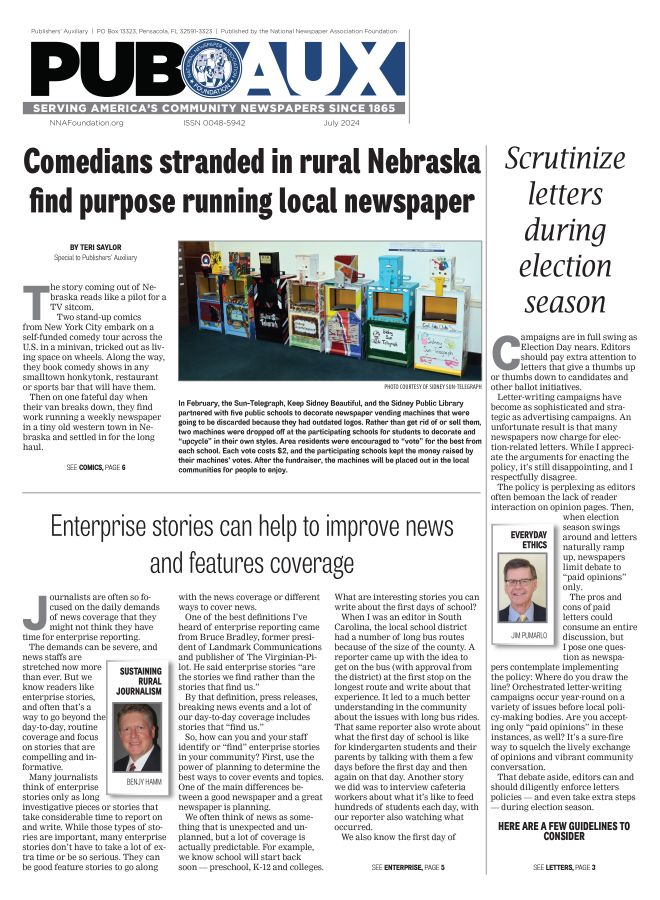‘I just did what needed to be done’
Oct 17, 2014
For new publishers, their newspaper is a sacred trust
By Teri Saylor
Special to Publishers’ Auxiliary
Holli Seehafer and Debbie Hemmer never set out to buy a newspaper, but when their bosses, Phyllis and Clarence Justice, both in their 90s and ailing, made them an offer they couldn’t refuse, they took over the Grant County Review in Milbank, SD, October 2013.
A month later, Phyllis died at the age of 97. Clarence, who has undergone treatment for cancer, resides in a local retirement home.
And Holli and Debbie have their hands full.
Growing up, the pair had no way of knowing how their lives would someday intersect, or how they would become business partners and publishers of a 134-year-old community newspaper, which had been much loved and cared for by a family who held it for more than a century.
Both women grew up as small-town girls near Milbank.
Debbie, who lived on a dairy farm, earned a degree in computer programming and jumped into the newspaper business in 1980, joining the Grant County Review.
As anyone who has ever worked for a small-town weekly newspaper knows, it hardly matters what you start out doing, it isn’t long before you are pretty much doing it all.
Debbie went down that path, too.
From bookkeeping, she took over sportswriting and became the sports editor. She worked as a photographer too, and then as photo editor, retreating into the darkroom each week to process film and print pictures. Then she got into composition, ad design and other areas of production.
When the aging owners entered a nursing home, Debbie took over management.
Holli went down a similar path.
After spending her formative years deeply involved in 4-H, she earned a degree in agriculture extension with minors in journalism and animal science from South Dakota State University.
She had her mind set on a career as an agriculture extension agent, but those careers were hard to come by without at least a master’s degree.
So Holli, who wasn’t ready to pursue a master’s, set her sights on working for a weekly newspaper where she could put her writing skills to good use.
She landed at the Grant County Review.
To Holli, who had grown up in Bristol, a three-acre town with a population around 300, Milbank seemed like a big city.
“Milbank has stoplights,” she said in a phone interview.
Holli started her career as a reporter and photographer at the Grant County Review in 1989. She covered sports and other events before transitioning over to the business side of the newspaper, selling ads and exploring technology, starting with handling e-mail.
“Like Debbie, I just did what needed to be done,” she said.
Holli left the newspaper when an opportunity opened up in her field of extension work, but when Phyllis entered a nursing home and a reporter had taken another job, Debbie asked her to come back to the Review.
In a recent conference call, Holli and Debbie spent more than an hour describing the Grant County Review, its history, its readers and the community it serves.
A classic railroad town, Milbank was founded in 1880 when the Chicago Milwaukee and St. Paul Railway built its line into South Dakota. Named for railroad director Jeremiah Milbank, the town was incorporated in 1894, according to information on the City of Milbank’s website.
The newspaper was born in 1880, too. The original owner sold it in 1909 and it changed ownership twice over the next two years, according to historical records. William Dolan bought it in 1911 and it stayed in the Dolan family for the next 102 years until Holli and Deb purchased it in 2013.
Milbank, the Grant County seat, is located in northeastern South Dakota, and backs up to the Minnesota state line.
In sports circles, the town is famous as the place where the American Legion first proposed the creation of an organized summer baseball league, which grew into American Legion Baseball, one of the largest youth sporting organizations in the world.
Largely rural, Grant County draws vacationers to its scenic Big Stone Lake, and pheasant hunting brings in outdoor enthusiasts.
“We also have a strong industrial base,” Holli said.
In addition to several granite quarries, the area is home to Valley Queen Cheese Factory, a leading employer with a global reach.
The U.S. Census reported 3,353 residents in Milbank in 2010, representing a nearly 300-resident drop since the turn of the 21st Century.
“Milbank is in a declining population trend,” Holli said.
Debbie views the declines as evidence to work even harder to keep the newspaper thriving.
“The newspaper is vital to keeping our community growing and to keep it moving forward,” she said.
When Clarence insisted the two women purchase his newspaper, he believed in them so strongly that he made it financially possible for them to take it over.
“We wondered who else would come here and publish the paper and do it well,” Debbie said. “So when he asked, I said ‘yes, I will do this.’ It was his desire, and he felt very strongly about it.’“
The two publishers describe Phyllis Justice as “a force.”
Phyllis, who was born in 1915, grew up working alongside her father at the Review, even though her mother tried to discourage her.
“Young ladies don’t belong at a newspaper,” Phyllis’ mother admonished her, according to Debbie.
“But Phyllis was a pioneer,” Debbie said.
Her obituary described her passion for journalism.
While attending South Dakota State College and later the University of Minnesota, where she graduated with majors in journalism and creative writing, Phyllis spent summers working at the Review. She started her popular humor column “Ain’t it Awful” in college and continued writing that column for her entire career, even when she held other jobs, until macular degeneration stole most of her eyesight.
She wrote features and “women’s news” at the Minneapolis Star-Tribune, worked with the USO, and spent a brief time working in public relations.
But her heart belonged to the Grant County Review, and from 1946 until 2013, she devoted her life to her newspaper and to her husband, Clarence, whom she met when her father hired him as a printer.
Phyllis was the first woman to serve as president of the South Dakota Newspaper Association, and was inducted into the South Dakota Newspaper Hall of Fame. The National Newspaper Association presented her the Emma C. McKinney Award in 1985.
Clarence and Phyllis did not have children, and considered their employees as family. Both Holli and Debbie were listed among Phyllis’ survivors in her obituary.
“The newspaper was their life,” Holli said. “They did everything together, and I don’t remember ever seeing one doing anything without the other, especially in their later years, and they were a team that ran the newspaper together.”
For Holli and Debbie, who had invested most of their lives in the newspaper and the community too, it felt like a tipping point when they realized how important it was for Clarence to know the newspaper would be in good hands.
“I knew I could run it,” Debbie said. “Doing this work has reaped rewards, and it was apparent that it would be a relief to Clarence for him to know the newspaper would continue, and it would be run the way they had run it during the past 100 years.”
For Debbie and Holli, maintaining tradition does not mean they have kept the newspaper in the dark ages. They have embraced technology and made the changes necessary to operate effectively in a 21st Century media world.
The newspaper is digitized fully behind a paywall. Its Facebook page has more than 1,000 friends, and has expanded the newspaper’s capacity and reach.
“When we cover an event, we print just a handful of photos in the newspaper, but we can post hundreds on Facebook,” Holli said.
Technology has also given them an additional revenue stream through the online sale of event photos.
But there is one thing the pair will never change, and Holli was clear about it.
“We want to remain a newspaper,” she said, emphasizing the word “paper.”
“We don’t use Twitter. We will not be posting news in 140 characters,” she said. “When news is online it is no longer a newspaper. We are a traditional newspaper, and we want to keep it that way.”
The community seems married to that concept, too, considering the way readers line up outside the Grant County Review office on Wednesdays waiting for the newspaper to return from the printer.
“Working at a weekly newspaper is not like a regular job,” Holli said. “The newspaper plays an integral role in our community, and our work contributes to keeping the community vital.”
Debbie agreed.
“We have been so much a part of the newspaper in the community’s consciousness, people think of us as the newspaper personified, and there is no off-duty,” she said.
Over the decades they worked for Clarence and Phyllis, the pair have learned lessons. They keep those lessons close to their hearts.
“I learned that an event or story may not matter to you, but it does matter to someone,” Debbie said. “I also learned you can’t please everyone when you become the owner, and the buck really does stop with you.”
Debbie and Holli are the Grant County Review’s first new owners in more than a century; a position neither takes lightly.
With reverence toward the past, and hope for the future, the pair maintain a close connection with Clarence, and never leave him out of the loop.
He gets the first newspaper off the press each week, special-delivered to him at his retirement home.
terisaylor@hotmail.com
Details:
Name of Newspaper: Grant County Review.
Owners: Debbie Hemmer and Holli Seehafer
How long have you owned the Grant County Review? One year. We took over Oct. 1, 2013.
Your newspaper’s circulation? 3,600.
Frequency of publication? Weekly.
List some top goals for the coming year? Increase our subscription list. Develop stories that interest our readers. Promote the local businesses to build a strong business community.
What are you most proud of? The Review’s slogan for 134 years has been ‘Everybody reads the Review!’ We are proud that the slogan still fits today. We often hear how a story or ad has gotten wonderful results because we published it in the paper.
What is your newspaper’s most distinguishing characteristic? The fact that for 102 years it was owned by the same family.
What is your newspaper’s biggest challenge? Grant County and Milbank are losing population and our biggest challenge will be to maintain or increase our number of subscribers in the coming years. Another challenge is reaching younger generations and proving to them that community newspapers are relevant in their lives.
How do you view your newspaper’s role in your community? We play a unifying role—bridging the need between businesses and organizations to reach members of the community, so that everyone can come together to build a strong community.
What do we love to hear from readers? That we are doing a great job and that our subscribers can’t wait for the paper to come out each week. For some, it is their lifeline to the community and they tell us they couldn’t be without it.
One thing we’d never change? Our commitment to the community. Even though we are a private company, making ends meet is secondary to providing a service to keep the residents of the community informed on the happenings in the county.
E-mail: gcreview@itcmilbank.com
Phone: 605-432-4516
Website: www.grantcountyreview.com







